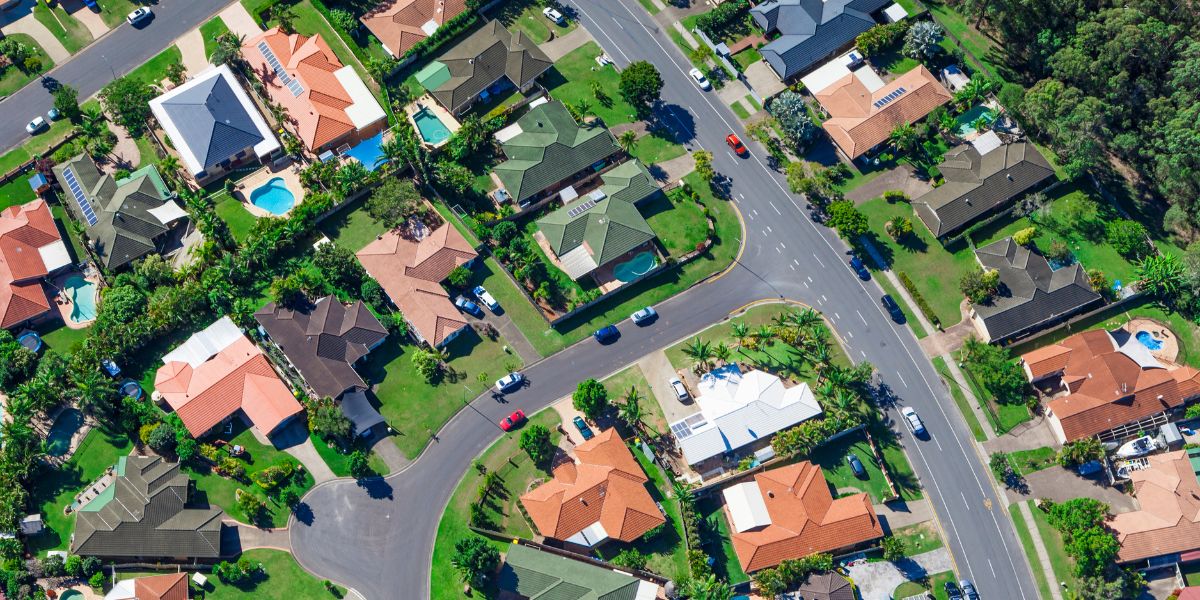Making housing more affordable: bridging the policy gap
“Housing affordability” and “affordable housing” are distinct but related policy objectives. Australia needs an integrated strategy that protects vulnerable groups while fostering an economy that supports quality, reasonably priced housing for all.

3 July 2024
Australia is at a turning point as home prices and rental rates have reached previously unheard-of heights. A dual strategy that considers both affordable housing and housing affordability is needed. Whilst these two terms are frequently used interchangeably, they refer to different facets of the issue. A wide range of economic factors, including housing affordability, influence how much of a household's income goes into housing. On the other hand, affordable housing focuses on giving those with lower incomes access to adequate housing alternatives.
Policymakers must understand these disparities to develop strategies that are inclusive of all demographics. We discuss these ideas in depth, examine the required policy changes and propose an integrated strategy to address Australia's housing crisis comprehensively.
Housing affordability versus affordable housing
The correlation between household income and housing expenses is reflected in housing affordability. Housing is usually deemed affordable if it accounts for no more than 30 per cent of a family’s total income. But this simplified measure hides how complicated the problem really is. The realistic affordability of a property is determined by several factors, including (but not limited to) its location, quality, and other expenditure like transportation and utilities.
If the home is located far from job centres, for example, the additional costs and time necessary for commuting may have a negative impact on the household's overall financial stability and wellbeing, even if the property meets the 30 per cent criterion. Housing affordability has an impact on broader economic processes as well. Overspending on housing can increase debt loads, lower disposable income, and restrict consumer spending. Every facet of the economy can be affected – from labour productivity to family instability.
The goal of affordable housing is to ensure that those with lower incomes can live in a secure, appropriately priced and safe environment. Supporting disadvantaged populations that are unable to participate in the private rental or homeownership markets is the main focus. Public housing, non-profit social housing, and subsidised rental buildings are common examples, aimed at keeping expenses within the budgets of lower-income households.
In Australia, initiatives for affordable housing often target families making less than 80 per cent of the median income, ensuring that mortgages or rent are set at a level that this group can afford over the long run. The National Rental Affordability Scheme (NRAS) and social housing projects, for instance, aim to enhance the availability of reasonably priced rental apartments for those with low to moderate incomes. These programs lessen homelessness and renting stress among the most vulnerable.
Why are these different definitions important?
Both housing affordability and affordable housing are part of Australia's current crisis. Individuals who cannot afford market-rate housing without financial aid are the emphasis of affordable housing. Meanwhile, housing affordability impacts a broader variety of income levels, specifically middle-income workers.
For instance, a middle-class family may find it challenging to afford excessive mortgage repayments or rent, but they may still locate homes in the private market. A low-income family, on the other hand, may depend on government help or subsidised housing to avoid homelessness.
Given this distinction, policymakers should implement specialised approaches. While affordable housing demands specialised subsidies and programs to directly lower housing costs for vulnerable groups, housing affordability measures might require broader economic policies like tax breaks and regulatory changes.
To develop policies that really make sense, one must thoroughly grasp these differences. Simply expanding the housing stock or offering tax incentives to first-time home buyers would not be adequate to meet the needs of the lowest-income households. Policies that give affordable housing first priority might similarly overlook more general market elements influencing house affordability for a broader population. A good policy framework has to strike a balance between the two approaches so that thorough measures fulfil both present needs and longer-term market stability.
Boosting housing affordability
Significant adjustments addressing supply, regulatory, and financial policies are required to enhance housing affordability.
First and most importantly, there has to be more houses delivered. More high-density developments close to employment and transportation hubs, and simplification of the planning procedures, will help. For example, streamlining zoning regulations and reducing red tape can accelerate the construction of new homes, thereby increasing housing supply and supporting price stabilisation. However, high-density areas frequently come with drawbacks, such as heightened traffic and noise levels. To ensure that high-density places continue to be liveable and sustainable, effective urban planning and infrastructure investment are crucial.
Second, significant investment demands for residential properties by Australian citizens, permanent residents, and foreign investors have a large impact on increases in house prices in Australia. In April 2024, for instance, 37 per cent of new loan commitments (seasonally adjusted) for housing are for investors.
Property is an attractive investment vehicle in Australia due to low political risks, relatively consistent price growth over time, stable rental income from high occupancy rates, tax incentives for property investors (e.g., negative gearing), and a lack of alternate investment opportunities reflecting the low complexity of the overall economy. Australia has dropped 38 places on Harvard's Economic Complexity Index in less than 30 years, now sitting at 93 out of 133 countries.
The other major determinant of excessive property investment in Australia is the welfare system, where citizens are encouraged to maximise their economic potential and accumulate wealth, particularly in real estate.
To reduce excessive property investment, policymakers should address the roots of the issue by, for example, diversifying the economy, maintaining a reasonable migration intake per year, and gradually removing tax incentives for property investment. For instance, a recent study demonstrated that encouraging foreign investment in Australia's construction sector (building new houses) can actually lower house prices while creating more jobs.
Additionally, discouraging vacant property ownership might help to increase market availability and fluidity. In Victoria, the vacant residential land tax (VRLT) applies to homes left unoccupied for more than six months.
According to Transparency International, money laundering also drives excessive property investment in Australia. A new federal initiative to battle money laundering is attempting to dampen excessive property investment by criminals and corrupt officials from developing countries.
Economic policy is mostly responsible for the affordability of housing. Changing home loan rates and giving first-time homebuyers tax advantages or credits could relieve some of the pressures on middle-class families. For individuals struggling with paying for their lodgings, direct financial aid—such as rental subsidies or housing grants—may also be of use.
Increasing affordable housing
Government incentives and concrete actions are required to increase supply of affordable housing. The first step is to increase funds for community and public housing. For people unable to pay market rates, government investments may boost supply of reasonably priced rental properties and provide stable housing. For instance, increasing the quantity of social housing available via programs such as the National Agreement on Social Housing and Homelessness (NASHH) may guarantee that more low-income households have safe accommodation. Social housing programs must also support vulnerable groups including low-income families, the elderly, and those with disabilities.
Encouraging the business sector to participate is also essential. Developers may be encouraged to include affordable housing units in developments by tax credits and subsidies. Inclusionary zoning mandating a proportion of newly constructed properties to be affordable could integrate affordable housing into comprehensive community planning. In the 2024-2025 budget, the Australian Government invested a further $6.2 billion in specific housing initiatives, taking the Government's total new investment since 2022 to $32 billion. This further enhances previous programs, including the Housing Australia Future, Social Housing Accelerator and National Housing Accord.
Most recently, the NSW Government has allocated funds for build-to-rent homes to attract domestic and foreign developers with a focus on essential workers. However, the eligibility criteria will be pivotal give there will be strong demand for these homes.
Creative solutions should also be explored, such as modular housing, which employs prefabricated units to cut building costs and timeframes, and community land trusts, which separate the ownership of land and houses to minimise costs. These strategies support social inclusion and community stability by ensuring that housing stays accessible and cheap over time.
Striking a balance
Comprehensive solutions require a balanced framework that tackles both affordable housing and housing affordability. We should aim for a more inclusive market where relief from affordability pressures is available to all income groups by concurrently increasing the supply of housing and delivering targeted affordable housing. Countries like Austria and Finland, with significantly improved housing outcomes, have shown the practicality of integrated frameworks that combine affordable housing programs with broader economic measures.
While programs for affordable housing guarantee that lower-income groups are not left behind, increasing the overall supply of housing may also moderate costs, benefitting middle-class families. In mixed-income housing complexes, for instance, building both market-rate and affordable apartments can promote resilient, varied communities. Global models may provide important insights into designing policies suited to Australia's particular market and socioeconomic conditions.
Politics, market dynamics and Australia’s socioeconomic profile will determine whether one strategy is given priority over the other. Focusing on housing affordability may produce generalised effects that help many people during a period of rapid inflation. On the other hand, boosting affordable housing initiatives might provide the most vulnerable necessary assistance in times of economic crisis or growing inequality. The best approach, however, is to combine both approaches, helping avoid the adverse consequences of ignoring one element, including worsening economic inequality or unsustainable housing bubbles.
Policymakers must take a holistic approach that balances general economic planning with targeted programmes for reasonably priced homes. This double emphasis guarantees thorough coverage and meets the demands of all income brackets, therefore encouraging long-term housing stability and economic welfare. Appropriate housing policies will not only help to relieve present constraints but also provide a sustainable foundation for future generations.
Dr Ehsan Noroozinejad Farsangi is a Senior Researcher at the Urban Transformations Research Centre, Western Sydney University, where he specialises in Smart, Resilient & Sustainable Construction. He previously focused on novel housing solutions in North America at UBC Smart Structures in Canada, and is an Associate Editor for several distinguished journals.
Dr Hassan Gholipour Fereidouni is an Associate Professor of Property in the School of Business at Western Sydney University (WSU) in Australia. Prior to joining WSU, he held Lecturer (2014-2017) and Senior Lecturer (2018-2020) positions in Economics at Swinburne University of Technology. Hassan is an active researcher in the fields of property economics, urban studies, tourism economics and Middle East economics.
Image credit: Getty Images
Features
Libby Hackett, Jordan Ward, Jack Isherwood, Bonnie Bley, Hannah Lobb, Isabella Whealing and Hugh Piper
Jack Isherwood and Annemie Verbeke
Subscribe to The Policymaker
Explore more articles
Cristy Brooks, Amelia Mardon and Mike Armour
Features
Libby Hackett, Jordan Ward, Jack Isherwood, Bonnie Bley, Hannah Lobb, Isabella Whealing and Hugh Piper
Jack Isherwood and Annemie Verbeke
Explore more articles
Cristy Brooks, Amelia Mardon and Mike Armour
Subscribe to The Policymaker








